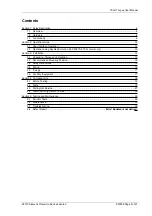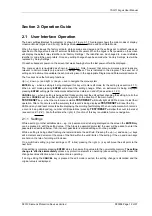
7SG11 Argus User Manual
©2013 Siemens Protection Devices Limited
P20006 Page 10 of 37
1.3.5.1 Time Stamping
All records are stamped with time and date using the Argus’ real-time clock feature. If the Argus is de-energised
then a capacitor provides a back-up supply to the real-time clock for a limited period. Time and date can be set
either via the fascia using appropriate commands in the System Configuration Menu, or via the communications
interface. In the latter case, Argus relays connected in a communications network can be synchronised by a
global command.
Synchronising pulses can be received via a status input. To use this feature one of the status inputs must be
assigned to the ‘Clock Sync’ feature in the Status Configuration Menu. Additionally the ‘Clock Sync Period’ setting
in the System Configuration Menu should be set either to ‘Seconds’ or to ‘Minutes’ as appropriate, depending on
the period of the synchronising signals expected from the controlling device. If ‘Seconds’ are selected then
energisation of the selected status input will result in the clock being synchronised to the nearest second with
milliseconds set to zero. If ‘Minutes’ are selected then the clock is synchronised to the nearest minute with
seconds and milliseconds set to zero.
1.3.5.2 Fault Records
The last 5 fault records are available from the Argus fascia with time and date of trip, measured quantities and
type of fault.
When issuing a trip output under fault conditions the Argus illuminates its TRIP LED, stores a fault record and
displays the fault indication screen. The fault indication screen displays a summary of the fault record, giving
immediate, simple information on what has occurred. It displays date (DD/MM), time (HH:MM:SS) and the poles
which were picked up when the trip signal was issued, for example:
25/04 17:25:51
TRIP A E
This display is held until the
TEST/RESET
button is pressed, upon which the LED turns off and any latched output
relays are reset. The Argus enters ‘Fault Data Display Mode’ at which point the fault indication screen is replaced
with a more detailed scrolling fault data display.
Fault 1
<<<fault data>>>
This shows date and time of fault, the active settings group at the point of trip, plus, for each pole the elements
picked up and the current measured at the time of trip. The information scrolls along the bottom line of the display.
External alarms are also shown in the fault record.
e.g. 12/05/04 15:32:47.2525 G1 PHASE A LS <IDMTL> HS1 HS2 IA = 12.32xIn...
The fault record is viewed in the ‘Fault Data Display Mode’ of the menu display system and can be viewed again
at a later date. Fault records are stored for the previous five faults. The five displays are numbered from 1 to 5
with fault 1 indicating the most recent record. It is necessary to define a ‘fault’ for these purposes. Depending on
the application, some of the protection outputs may be used for alarm purposes rather than for tripping. In such
cases it would be undesirable for the Argus to light its TRIP LED and give fault indication.
Therefore, a ‘Fault Trigger’ setting is included to allow the fault condition to be defined by selecting any
combination of output relays as tripping outputs. The TRIP LED and the fault record storage will be triggered
when any of the selected output relays are energised. Note that a trip output can still be generated even if the
‘fault trigger’ setting is not used, but no trip indication is given. Fault records are stored in non-volatile memory.
1.3.5.3 Disturbance Recorder
The waveform record feature stores analogue and digital information for all current inputs, status inputs and
output relays. On some relays voltage signals are also stored. The ‘Waveform Trigger’ setting is used to enable
the waveform record feature. Waveform storage is triggered by operation of any function selected in the
‘waveform trigger’ setting. In addition, a record can be triggered remotely via a status input or via the serial
communications interface. Waveforms are stored in a 1 second, rolling ‘time window’. The 1 second data window
has a settable pre-fault triggering capability. There is capacity to store five waveform records, with any new
record over-writing the oldest. All records are time and date stamped. Waveform records are stored in RAM with
a capacitor providing back-up during breaks in auxiliary supply.
The waveform record store can be erased when viewing the “waveforms” instrument screen and pressing the
TEST/RESET
button.
1.3.5.4 Sequence of Event Records
The Argus event recorder feature allows the time tagging of any change of state. Each event is logged with the
full date and time and actual event condition every 2.5msec. The following events are logged:






























